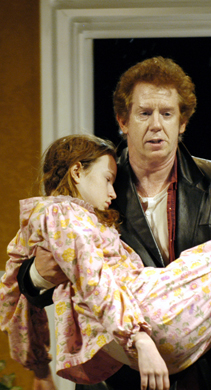
|
JOE EGG
|
|
|
|
JOE EGG
Desperate laughter By Lawson Taitte / The Dallas Morning News After a nice lunch where we dish about the national and local theater scenes, Dallas Theater Center artistic director Richard Hamburger takes me to the hall where he’s rehearsing Peter Nichols’ A Day in the Death of Joe Egg. Mr. Hamburger has been a fan of the piece since he saw it on Broadway as a child. The 1967 play – the Theater Center is just calling it by its nickname, Joe Egg – deals with an English couple, Bri and Sheila, whose daughter is severely handicapped. It’s weighty, but also very funny. The very visually oriented director begins talking about the show at the tabletop model created by his great set designer, Michael Yeargan – this year’s Tony Award winner for The Light in the Piazza. Richard Hamburger: “I said to Michael, ‘The actual living rooms in Bristol in 1967 are going to be too dreary, and I don’t want to look at that all night.’ Also, there is this sort of vaudevillian, you know, frame around” the action. Lawson Taitte: “There are two huge frames there, as if putting the action in a painting ... they’re actually part of the set?” RH: “Yeah, there are two frames. And ... well, maybe I shouldn’t.” He pulls down a brightly colored piece from the model’s flyspace. “This comes down at intermission. It will be smaller, because we couldn’t afford it at this size.” LT: “Oh, it’s neon?” RH: “It’s neon. That’s our show curtain, basically. “I think we’ve found a way to be very true to the play and the necessary claustrophobia that Bri would want to escape from. At the same time, there’s all these Christmas lights up in there. I said to Michael, ‘Let’s have this sense of a firmament.’ I love Christmas lights. ‘Let’s use that so the package of the story is bright and cheerful and fun to look at – at the same time maintaining a domestic environment.’ “There is so much that is meticulously local, domestic about the play. This is about a marriage. This is about two people and their child, so you have to have” a domestic feel. “It’s also a very funny play that feels like stand-up a lot of the time. So the bright colors, I think, would fit that.” LT: “How do you handle all the comedy in this ultimately very serious play?” RH: “I’ve seen films of a couple of versions, and they either veer toward sit-com or toward the really, really, really dreary. So it’s really about achieving the perfect balance. “It’s all about giving the actors a solid footing to live in and breathe in as a family, as a couple with their child. And at the same time creating the vaudevillian frame, but not doing it as broadly as having chaser lights and footlights, but being slightly more sophisticated and subtle about it. “Peter Nichols has said that he feels he’s written a love story about a marriage. But then the play itself explodes in a Pirandellian way with continuous use of a direct address to the audience.” LT: “Every character gets a monologue.” RH: “Every character ... but they’re of different kinds. But establishing that vocabulary for the actors – and for the lighting designer ... What is a [comedy] routine, as opposed to an inner monologue? ... The routines are something that the couple use as a way to survive their situation, through humor. “But the inner monologues, although they’re rife with humor, often hilarious humor, are actually a slice of someone’s inner life. ... Some are conversations with the audience, where they’re looking for something from the audience. They’re looking often for confirmation that choices they’ve made are right. Or they’re looking for sympathy. “So it has been my task as a director to say, ‘What do you want when you’re addressing the audience, very specifically ... and who in the audience? Where? There may be different kinds of people in the audience. Some of them agree with you, some are disagreeing. So who’s talking back to you, and make that specific.’ “ LT: Why resurrect this play now? RH: “Joe Egg has always been a play I’ve been drawn to and always on my short list – perhaps from seeing it as a kid. It really stuck in my mind as a hidden jewel, a play that isn’t often done. It resurfaces every 10 years. People find it hilarious, tender, disturbing, moving. And they seem to discover it anew. So it has stood the test of time as a small masterpiece, a vehicle for wonderful actors who can be edgy, hilarious and real at the same time. “I think also the Terry Schiavo [controversy] last spring when I was choosing the season” influenced the decision. “The issues about what is truly compassionate toward our loved one, care-taking. How do we take care of someone who is very, very ill without destroying our own lives? “This play gets into some very, very serious issues that we all deal with – it gets into them in extreme ways, but that’s what the theater does. It’s really quite a riveting exercise in some of the most profound issues that face us: Do you cut and run? Do you sacrifice your own personal self for your marriage, for your family? How much do you fulfill yourself at the expense of other people? How do we grapple with people who are in so-called vegetative states? Are they in vegetative states? Or is there a person that’s hidden there, like Christy Brown in My Left Foot?” |
|
© Richard Hamburger, Theater Director Site design and maintenance by Amy Lacy.
|



